Fabric Wool Felt:Premium Quality for Crafting and Industrial Solutions
Fabric wool felt is made primarily from natural wool fibers, often blended with other materials like polyester or acrylic for added durability and flexibility. The wool fibers are compressed, matted, and pressed together through a combination of heat, moisture, and mechanical pressure to create a dense, soft fabric. The result is a versatile material with a unique texture that is used for a variety of applications, ranging from fashion accessories to industrial products.
Fabric Wool Felt
We are a fabric supplier from China. Our main products are Quilting Collection, Apparel Collection, Home Décor Collection.
Fabric Wool Felt
Durability
Fabric Wool Felt is remarkably durable, providing long-lasting performance even under stress. Its tightly matted fibers create a dense structure that resists wear and tear. The resilience of wool felt makes it ideal for products that undergo frequent use, such as footwear, bags, and upholstery. Unlike other fabrics, wool felt does not fray easily, making it a reliable option for both decorative and functional applications. Furthermore, wool’s natural elasticity helps the material maintain its shape, contributing to the longevity of the product.
Insulating Properties
One of the standout features of fabric wool felt is its natural insulating properties. Wool is known for its ability to regulate temperature by trapping air within its fibers. This makes wool felt a great material for insulation in both fashion and industrial products. In clothing, wool felt helps keep the body warm by trapping heat close to the skin. Similarly, in industrial applications, wool felt provides excellent soundproofing and thermal insulation, making it useful in construction, automotive, and machinery applications.
Eco-friendly
Fabric wool felt is an environmentally friendly material, as it is made from natural, biodegradable wool fibers. Wool is a renewable resource that can be replenished yearly without harm to the sheep. The production of wool felt can also be more sustainable compared to synthetic alternatives, which are derived from petroleum-based products. Moreover, the wool felting process typically uses fewer chemicals and resources, further enhancing its eco-friendliness. As consumers become more conscious of their environmental impact, wool felt offers a sustainable option for eco-conscious projects.
Versatility
Wool felt is a highly versatile material, making it suitable for a wide range of uses. Whether it’s cut into shapes for crafting, molded into 3D designs, or used as padding in industrial settings, wool felt adapts to many different applications. It can be dyed in vibrant colors and easily sewn, making it a favorite for crafters. Its ability to hold shape without fraying allows it to be used for functional and decorative purposes in industries such as fashion, home décor, and automotive manufacturing.
Fabric Wool Felt by Composition
Fabric wool felt can be categorized by its composition, primarily distinguishing between 100% wool felt, wool-blend felt, and organic wool felt. Pure wool felt provides natural insulation, eco-friendliness, and a soft texture, while wool-blend felt combines wool with synthetic fibers for added durability and affordability. Organic wool felt is made from sustainably sourced wool without harmful chemicals, appealing to eco-conscious users. By choosing felt based on composition, you can tailor your selection to match project needs for purity, sustainability, or strength, ensuring ideal functionality and texture.
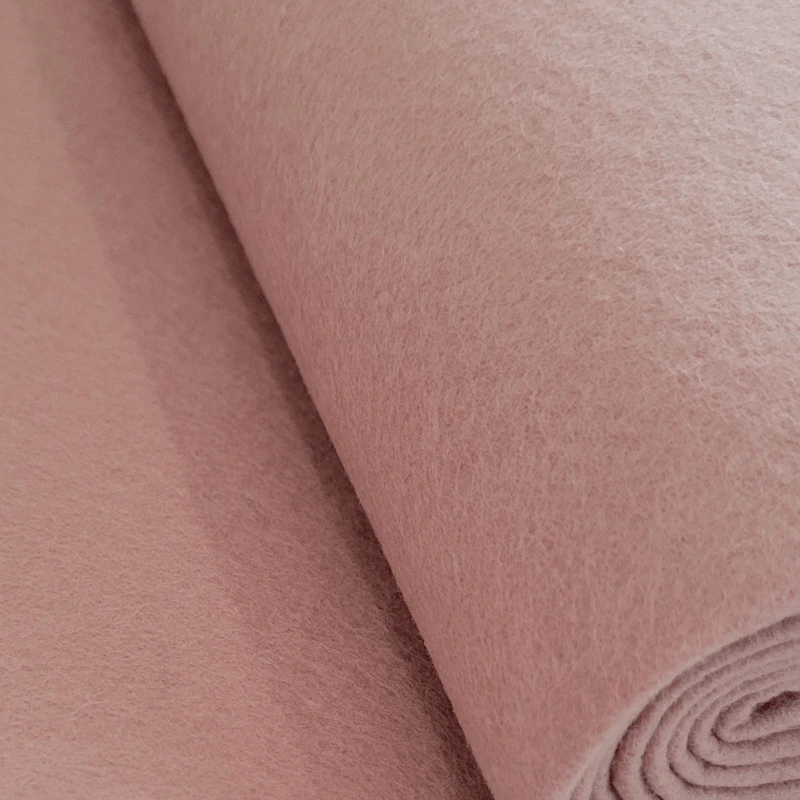
100 wool felt fabric
100% Fabric Wool Felt is made entirely from pure wool fibers, offering a natural, dense, and high-quality material. This felt is known for its durability, natural insulation, and flame-resistant properties, making it an ideal choice for both creative and industrial applications. You’ll find it particularly useful for projects where purity and authenticity are essential, as the wool provides a unique, soft texture and superior resilience. Additionally, 100% wool felt is eco-friendly and biodegradable, aligning with sustainable practices and giving you a fabric that’s as kind to the environment as it is versatile in use.
wool blend felt fabric
Wool blend felt fabric combines wool fibers with synthetic materials like polyester, balancing quality with cost-effectiveness. This blend results in a felt that’s soft yet more durable than pure wool, as synthetic fibers add strength and resilience. With its blend, you benefit from the natural warmth and texture of wool but with added flexibility and a wider color range, making it great for crafts, home décor, and accessories. Wool blend felt is an affordable choice if you’re seeking a high-quality yet economical material that still offers excellent durability and a comfortable feel.

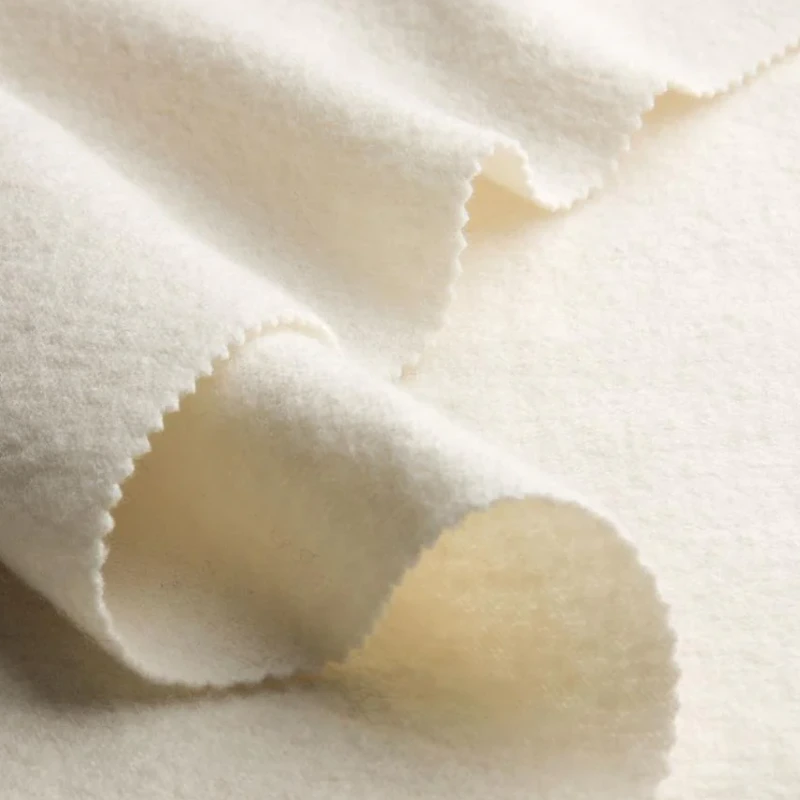
organic felted wool fabric
Organic felted wool fabric is crafted from wool that’s sustainably and ethically sourced, adhering to organic farming standards. This ensures that no harmful chemicals are used in raising the sheep or in processing the wool, providing a healthier, eco-friendly alternative. As a result, organic wool felt retains the natural properties of wool, like its insulating warmth, breathability, and moisture resistance, without any synthetic additives. Choosing organic felted wool fabric means you’re supporting sustainable practices and enjoying a material that’s gentle on both your skin and the environment, ideal for eco-conscious projects.
Fabric Wool Felt by thickness
Classifying wool felt by thickness, you’ll find options ranging from thin (around 1-2mm) to medium and thick (over 5mm). Thin wool felt is ideal for detailed crafts and appliqué due to its flexibility and ease of cutting. Medium thickness offers a balance of structure and softness, suitable for accessories and home décor. Thick wool felt, including heavy-duty and industrial options, provides durability, insulation, and cushioning, ideal for upholstery, padding, and soundproofing applications. By choosing felt by thickness, you can match the material’s strength and flexibility to your project’s specific requirements.
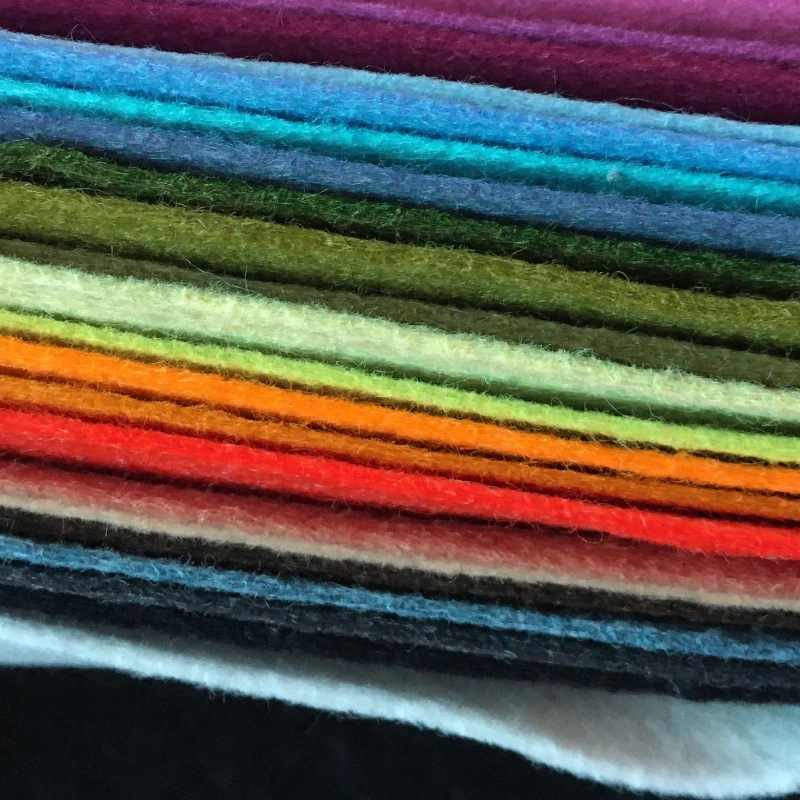
2mm wool felt fabric
2mm wool felt fabric is a lightweight, versatile option suitable for projects requiring a thin yet durable material. With its slim profile, this felt is easy to cut, sew, and shape, making it ideal for precision work in crafts, appliqué, and delicate decorative items. You’ll find it useful for detailed designs and projects that need a flexible fabric, while still benefiting from the natural insulating and moisture-wicking properties of wool. Despite its thinness, 2mm wool felt offers resilience and a smooth texture, allowing you to add a touch of quality to both artistic and functional applications.
thick wool felt fabric
Thick wool felt fabric provides a robust, dense material ideal for heavy-duty applications where structure and durability are essential. This type of felt offers excellent insulation and sound-absorbing qualities, making it popular in industrial, automotive, and interior design projects. It holds its shape well and resists wear, so you can use it confidently for upholstery, padding, or protective liners. The added thickness enhances the natural warmth and cushioning of wool, giving you a high-performance material that’s both comfortable and resilient, suitable for projects that require a stable, long-lasting fabric.

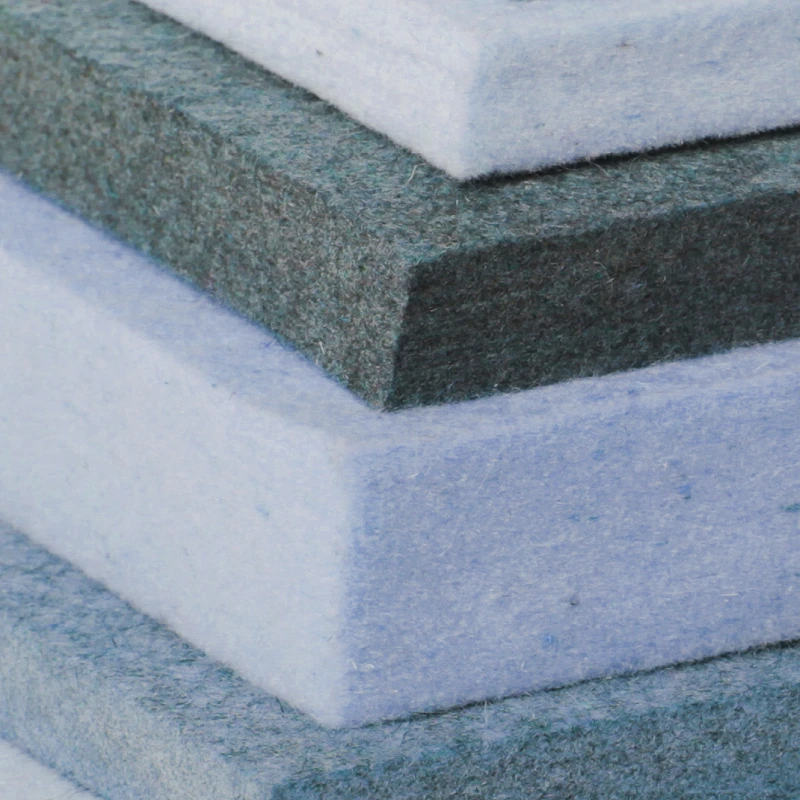
heavy wool felt fabric
Heavy wool felt fabric is an exceptionally dense and durable material, crafted for projects that demand superior resilience and stability. Its thick, weighty structure provides outstanding insulation, soundproofing, and impact resistance, making it a go-to choice for industrial applications like machinery padding, gaskets, and automotive parts. You’ll also find it effective in interior design for applications like area rugs, wall panels, and protective surfaces, as it absorbs sound and offers a plush, luxurious texture. With its robust construction, heavy wool felt holds up well against wear and tear, giving you a material that combines the natural warmth and strength of wool with excellent functional properties.
Fabric Wool Felt by Color
Fabric wool felt is available in a wide range of colors, from natural wool shades to vibrant dyed options. Natural-colored felt, in shades of cream, brown, and gray, offers a rustic, organic look, ideal for eco-friendly projects. Dyed wool felt comes in endless color choices, perfect for adding a bright, custom look to craft projects, accessories, or interior décor. Whether you’re aiming for a subtle, earthy palette or a bold and colorful design, selecting felt by color enables you to enhance your project’s visual appeal and achieve the desired aesthetic.
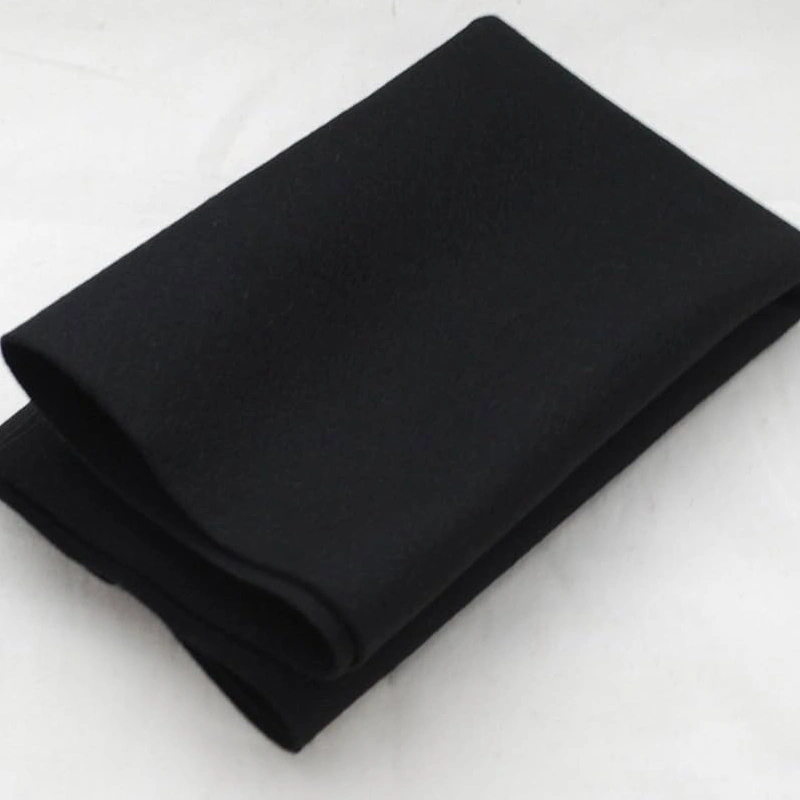
black wool felt fabric
Black wool felt fabric offers a sleek, modern aesthetic with versatile functionality. Its dark hue provides excellent contrast, making it ideal for projects where details and shapes need to stand out, such as in appliqué, art pieces, or accessories. The natural warmth and durability of wool combined with black’s elegance make this felt perfect for professional and industrial applications, including interior décor and protective padding. Black wool felt also hides stains well, adding to its practicality in high-use areas while lending a sophisticated touch to creative and functional projects.
white wool felt fabric
White wool felt fabric has a classic, clean look that’s ideal for projects requiring a neutral background or a soft, natural aesthetic. Its crisp color makes it a popular choice for craft projects, holiday decorations, and soft furnishings, where it offers a pristine appearance. Additionally, white wool felt works well in applications that involve dyeing or custom colorwork, as it takes color beautifully. Its soft texture and insulating properties make white wool felt a versatile option for everything from children’s toys to stylish décor accents, combining elegance with the warmth of wool.
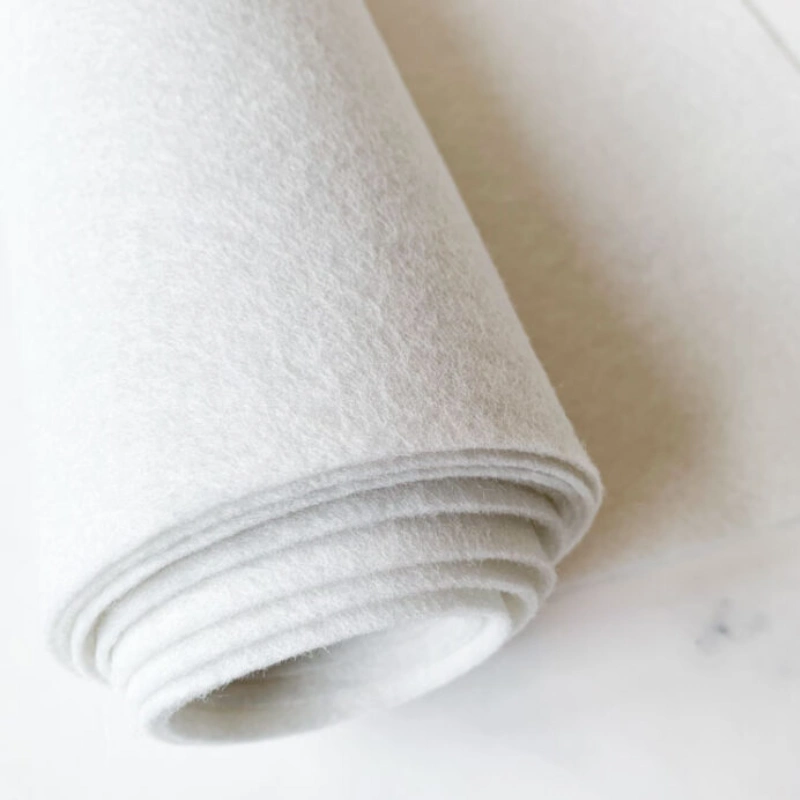

grey wool felt fabric
Grey wool felt fabric provides a neutral, timeless color that’s practical and stylish. Its mid-tone shade makes it perfect for minimalistic and contemporary designs, blending easily with various color schemes. Grey wool felt is commonly used in interior design for items like rugs, wall panels, and furniture upholstery, as it’s less prone to visible dirt than lighter colors. Additionally, the durability and warmth of wool make grey felt a suitable material for both decorative and functional applications, allowing you to achieve a sophisticated, understated look in any project.
red wool felt fabric
Red wool felt fabric adds a bold, vibrant pop of color to any project, making it ideal for festive decorations, fashion accessories, and standout décor pieces. The rich color of red wool felt brings warmth and energy, perfect for creating eye-catching elements in crafts or artistic applications. Its natural wool composition ensures softness, durability, and insulation, making it a practical choice that balances function with aesthetics. Red wool felt is a versatile option for those looking to add a lively, dynamic touch to their designs while enjoying the warmth and texture of quality Fabric Wool Felt.
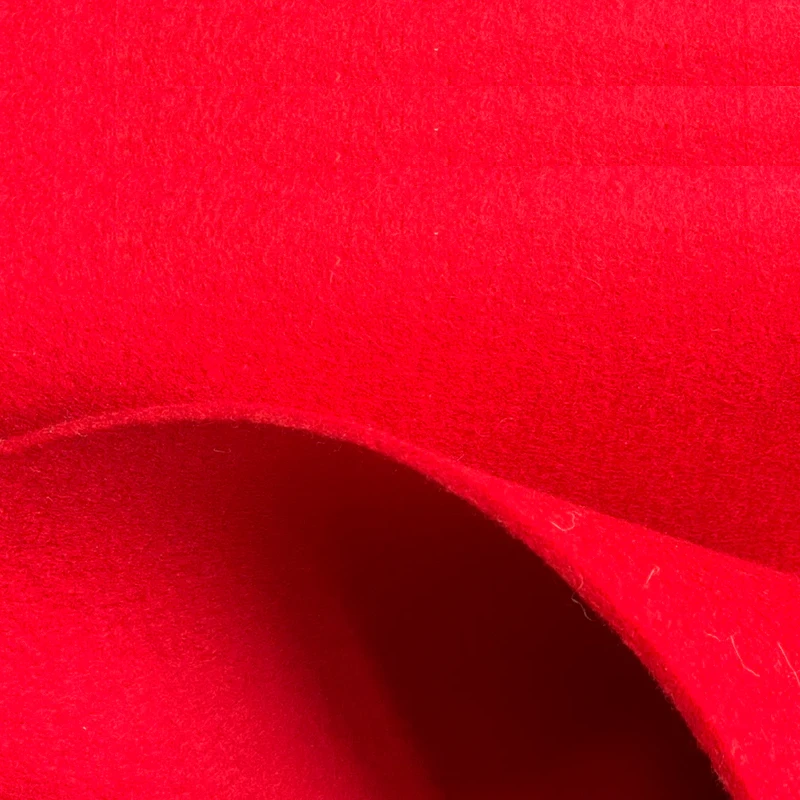
Fabric Wool Felt Special Treatment and Production Method
how to felt wool fabric
Materials Needed:
Fabric Wool Felt,Hot water,Soap ,A clean surface for felting (a basin or bathtub),Bubble wrap or a bamboo mat ,Towel for drying
Steps:
Prepare Your Workspace:
Lay down a towel on the surface you will be working on to absorb excess water.
Fill a basin or bathtub with hot water. The water should be as hot as you can handle but not boiling.
Prepare Your Wool:
If you’re using wool fabric, ensure it’s 100% wool, as blends may not felt properly.cut your wool fabric to the desired size if necessary.
Soap the Fabric:
Add a few drops of soap to the water. Swirl it in to create soapy water.
Place the wool fabric in the soapy water, ensuring it’s completely submerged.
Agitation:
Gently agitate the fabric by moving it around in the water. You can also use bubble wrap or a bamboo mat to press and rub the fabric to encourage felting.
Continue this process for about 10-15 minutes, adding more hot water if it cools down.
Rinse and Check for Felting:
After sufficient agitation, check if the fibers have begun to mat together. If they are still loose, continue agitating.
Once felted to your liking, rinse the wool fabric in cool water to remove soap and stop the felting process.
Drying:
Gently squeeze out excess water (do not wring).
Lay the felted wool flat on a clean towel to dry, reshaping if necessary.
hand dyed felted wool fabric
Materials Needed:
Fabric Wool Felt ,Dye ,Gloves,Containers for dyeing
Scraps for testing colors,A heat source stove or microwave ,Water
Plastic wrap or plastic bags,Vinegar (for acid dyes)
Steps:
Set up a well-ventilated workspace with all materials within reach. Wear gloves to protect your hands.
Soak the Wool:
Before dyeing, soak the felted wool in warm water with a splash of vinegar (for acid dyes) for about 30 minutes to allow for better dye absorption.
Prepare the Dye:
If using acid dye, follow the manufacturer’s instructions to mix the dye with water in a container.
If using natural dyes, prepare your dye from plants (e.g., avocado pits for pink, turmeric for yellow) by boiling them in water.
Dye the Wool:
Place the wet felted wool into the dye solution, ensuring it’s fully submerged. You can use different containers for different colors or tie-dye techniques.
For acid dyes, apply heat by simmering the dye bath or using a microwave. For natural dyes, soak the fabric to achieve the desired color.
Check the Color:
Check every 10-15 minutes until you reach your desired color saturation. Keep in mind that wet colors may appear darker than when dry.
Rinse and Set the Color:
Once the wool reaches the desired color, carefully remove it from the dye and rinse under cool water until the water runs clear.
If using acid dye, you might need to add a vinegar rinse to help set the color.
Drying:
Let the dyed wool fabric dry flat on a towel or drying rack away from direct sunlight.
Fabric Wool Felt FAQs
What is fabric wool felt made of?
Fabric wool felt is made from natural wool fibers that are matted together using heat, moisture, and pressure. Sometimes, other fibers such as polyester or acrylic are added to enhance durability and texture, but wool remains the primary material.
Is wool felt biodegradable?
Yes, wool felt is biodegradable, as it is made from natural wool fibers. This makes it an eco-friendly material that decomposes naturally without harming the environment.
What are the main uses of wool felt?
Wool felt is used in a variety of applications, including clothing, accessories, toys, home décor, and industrial products like soundproofing, insulation, and filters. Its versatility makes it suitable for both creative and functional uses.
Is wool felt durable?
Yes, wool felt is known for its durability. The dense fibers make it resistant to wear and tear, ensuring long-lasting performance. It holds up well under frequent use and does not fray easily.
Can wool felt be dyed?
Yes, wool felt can be dyed in various colors. It takes dye well, making it a popular material for craft projects where vibrant colors are needed. Wool felt retains its color and texture after dyeing, adding to its appeal in artistic applications.
Please feel free to contact us now if you are interested in our Fabric Wool Felt~
